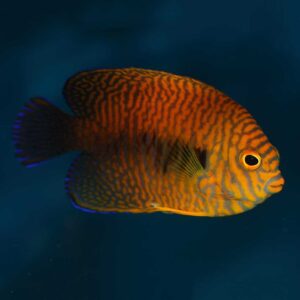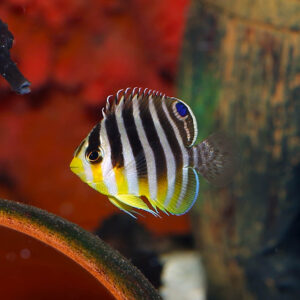The Aiptasia Eating Filefish, scientifically known as Acreichthys tomentosus, is a stunning fish with mottled colours. It has a slender body shape and can grow up to a maximum size of approximately 4 inches (10 cm). The body of this filefish is covered with a mottled pattern of yellow, brown, and white, allowing it to blend in with its natural reef environment.
Natural Habitat:
In its natural habitat, the Aiptasia Eating Filefish resides in the vibrant coral reefs of the Indo-Pacific region. These reefs are characterized by their abundant and diverse marine life, including corals, anemones, and other reef organisms. The filefish can be found among the crevices and coral branches, utilizing its natural camouflage to seek shelter and explore its surroundings.
Keeping the Aiptasia Eating Filefish Healthy:
The Aiptasia Eating Filefish is considered to have a moderate care level. Providing stable water conditions, maintaining appropriate temperature and pH ranges, and ensuring a well-maintained aquarium environment are essential for their well-being. Regular water parameter testing, and quality filtration are necessary to keep this delicate species thriving.
Special Requirements and Feeding:
One of the unique characteristics of the Aiptasia Eating Filefish is its appetite for Aiptasia anemones, which are often considered pests in aquariums. They can help control the population of these unwanted anemones. In addition to Aiptasia, their diet should include small crustaceans and other small invertebrates. Offering a varied diet consisting of high-quality frozen and live foods will help ensure their nutritional needs are met.
How Many Should I Keep?
When it comes to keeping Aiptasia Eating Filefish, it is recommended to keep them individually or in pairs. They are generally peaceful, but they may exhibit territorial behaviour towards conspecifics and similar-looking fish. Providing adequate space and hiding spots in the aquarium will help reduce potential aggression and provide each fish with its own territory.
Lighting Preference:
Aiptasia Eating Filefish thrive in aquariums with moderate to high lighting levels. Mimicking the intensity and spectrum of natural sunlight will support their overall health and enhance the vibrant colours they display.
Suitable Tank Mates:
The Aiptasia Eating Filefish is generally compatible with peaceful reef tank inhabitants. Suitable tank mates include other non-aggressive fish species and invertebrates that are not likely to be seen as food or territorial threats. However, caution should be exercised when keeping them with delicate corals or other ornamental invertebrates, as they may nip at them.
Reproduction in the Wild:
The specific details regarding the reproduction of Aiptasia Eating Filefish in the wild are not extensively documented. Further research is needed to understand their reproductive behaviours, including courtship, spawning, and the rearing of their offspring.
Breeding Acreichthys tomentosus:
There is limited information available regarding the breeding of Acreichthys tomentosus in captivity. The successful breeding of this species requires specialized conditions, such as the availability of suitable spawning substrates and proper diet. Further research and dedicated efforts by experienced aquarists are necessary to establish effective breeding protocols.
Sexual Dimorphism:
Aiptasia Eating Filefish exhibit minimal sexual dimorphism, making it challenging to visually distinguish between males and females based on physical characteristics alone.
Distribution:
The Aiptasia Eating Filefish, Acreichthys tomentosus, is naturally occurring in the Indo-Pacific region. Its distribution spans various areas, including the Red Sea, Indian Ocean, and the Pacific Ocean. The wild populations of this species can be found in coral reefs and their associated habitats within these regions.
Summary:
The Aiptasia Eating Filefish, Acreichthys tomentosus, is a visually captivating fish known for its vibrant colours and unique feeding behaviour. With a moderate care level, it requires stable water conditions, a varied diet, and a well-maintained aquarium environment. Its primary role as a natural Aiptasia control agent makes it a valuable addition to reef tanks. While suitable tank mates are available, caution should be exercised when housing them with delicate corals or ornamental invertebrates. Further research is needed to understand their reproductive behaviour and establish successful breeding protocols. This delicate species contributes to the beauty and diversity of marine aquariums, captivating aquarists with its striking appearance and beneficial role in maintaining a healthy reef environment.





Reviews
There are no reviews yet.